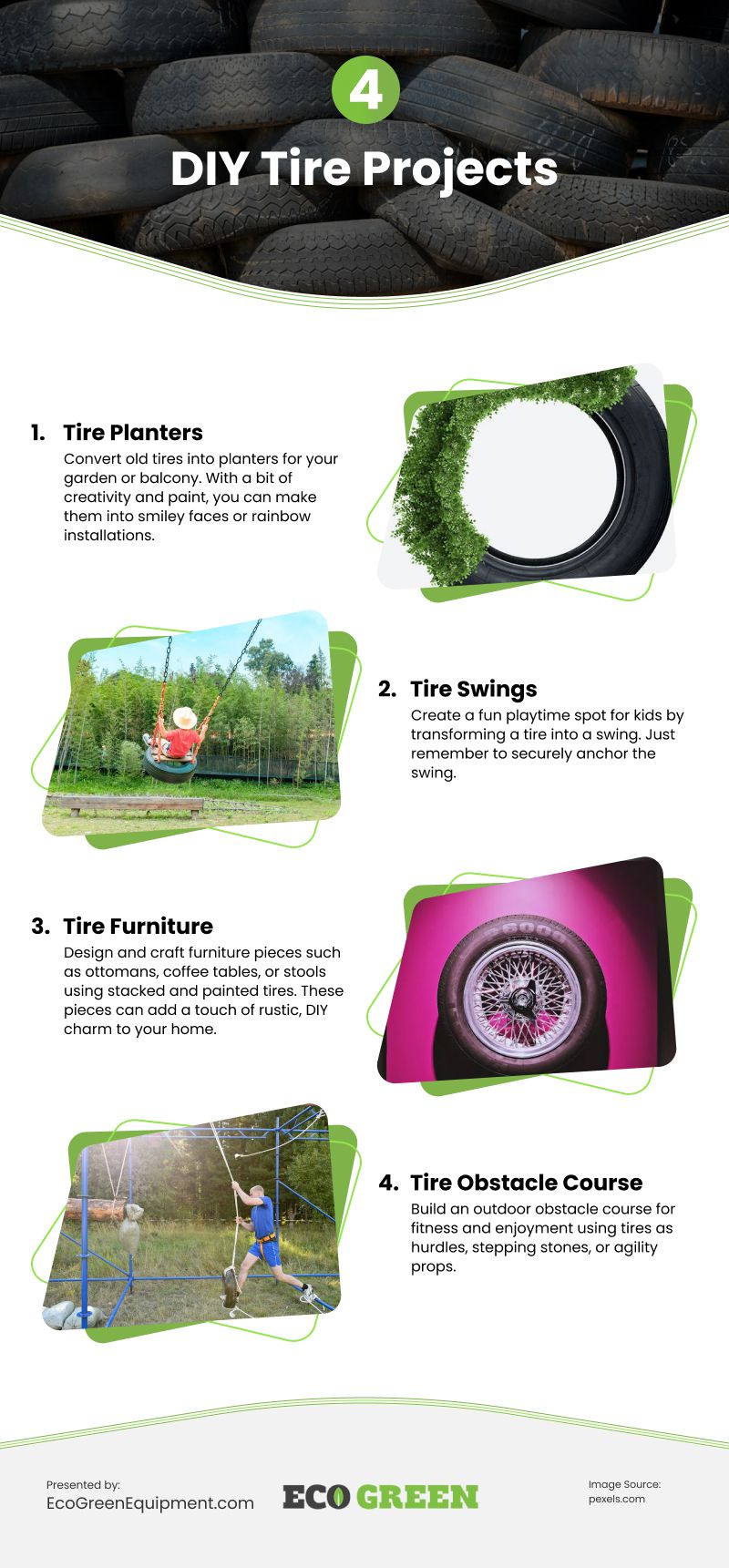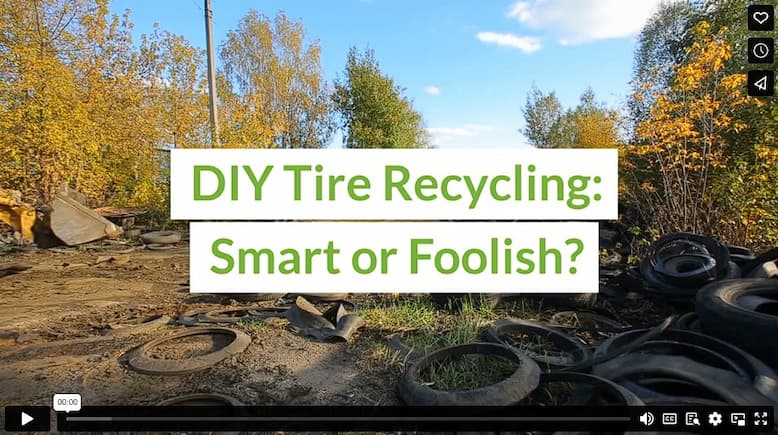DIY is in our DNA. Nobody likes feeling helpless or reliant on experts to solve their problems. It makes sense. We are enormously social animals, but we have learned over hundreds of thousands of years that if you can’t do the basic things yourself, you might get left behind or kicked out of the clan.
Nowadays, it’s much less an issue of life and death, but self-reliance still sends social signals to friends and our communities. This is encapsulated in jokes about how many people it takes to change a light bulb.
DIY tire recycling is as old as tires. When a tire becomes too worn, it no longer gains adequate traction on the road. Regular safety inspections may require replacing these end-of-life tires. The used tires are bulky, heavy, and hard to transport, so it is not uncommon for them to stack up over the years. At some point, they need to be dealt with. In this blog post, we’ll explore the perils of DIY tire recycling, outline safe DIY projects, and delve into the expert methods for responsibly recycling tires.
The Dangers of DIY Tire Recycling
1. Health Hazards:
Handling used tires without the proper equipment and precautions can pose significant health risks. Tires can accumulate harmful chemicals, including heavy metals, which can contaminate the soil and air when not processed correctly. Inhaling toxic fumes or coming into contact with hazardous materials can lead to severe health consequences.
While old tires might seem similar to a log or rock, they are less benign since they are made of synthetic and highly manufactured materials. One or two tires won’t harm you, but accumulating a backyard full of them can.
2. Fire Hazard:
Tires are notorious for being highly flammable and impossible to extinguish. Attempting to cut, heat, or manipulate them without the appropriate knowledge and tools can result in uncontrollable fires. An uncontrollable fire doesn’t have a happy ending. DIY tire recycling projects often lack the fire suppression systems and safety measures found in professional recycling facilities.
3. Environmental Impact:
DIY tire recycling can inadvertently harm the environment. Inadequate disposal methods can lead to creating the perfect breeding ground for disease-carrying pests, like mosquitoes and rodents. Improperly recycled tires may leach harmful pollutants into the soil and contribute to waterway pollution. Like microplastics, it’s often hard to see the negative impact on the environment outright or for a number of years. It’s sad that so many DIY tire recyclers are trying to help the environment by disposing of waste but often end up making things worse.
Safe and Sustainable DIY Tire Projects
While large-scale DIY tire recycling poses risks, there are responsible and safe ways to repurpose used tires at home.
1. Tire Planters:
Convert old tires into planters for your garden or balcony. With a bit of creativity and paint, you can make them into smiley faces or rainbow installations.
2. Tire Swings:
Create a fun playtime spot for kids by transforming a tire into a swing. Just remember to securely anchor the swing.
3. Tire Furniture:
Design and craft furniture pieces such as ottomans, coffee tables, or stools using stacked and painted tires. These pieces can add a touch of rustic, DIY charm to your home.
4. Tire Obstacle Course:
Build an outdoor obstacle course for fitness and enjoyment using tires as hurdles, stepping stones, or agility props.
Professional Tire Recycling Practices
This is what the experts do with old tires. It’s not an overly complicated process, and if you have the vision and invest in tire recycling equipment, you could become a tire recycling specialist in no time.
1. Collection and Sorting:
Recyclers collect tires from various sources, including individuals, tire retailers, and automotive shops. They are then categorized based on their condition and type.
2. Shredding:
The tires are shredded into smaller pieces to make the recycling process more manageable. These rubber chips are easier to handle and transport.
3. Pyrolysis or Mechanical Recycling:
There are two main methods used for recycling tires after shredding:
- Pyrolysis: Involves heating tires in the absence of oxygen to break them down into valuable byproducts such as carbon black, pyrolysis oil, and steel.
- Mechanical Recycling: In this method, the rubber from tires is broken down into smaller pieces to create various products, including asphalt additives, playground surfaces, and rubber mats.
4. Quality Control:
Recycled rubber products undergo rigorous quality control tests to ensure they meet safety and performance standards.
Wise Recycling Choices
While DIY projects can be a fulfilling way to repurpose old tires, nobody should underestimate the dangers of large-scale DIY tire recycling. To contribute to a sustainable future and avoid health hazards, stick with the fun, creative, and safe tire recycling methods. Leave the intricate process of professional tire recycling to the experts who have the knowledge. There’s always more to learn about tire shredder equipment and how rubber recycling plants extract valuable resources from old tires.
Video
Infographic
When a tire becomes too worn, it no longer provides sufficient traction on the road. Used tires are bulky, heavy, and hard to transport. They often accumulate over the years and need to be dealt with. Discover safe and sustainable DIY tire projects in this infographic.






